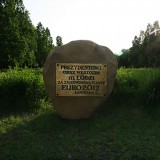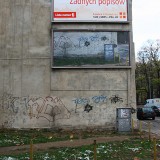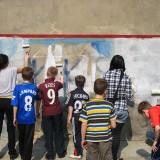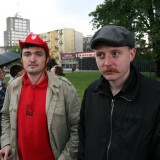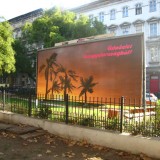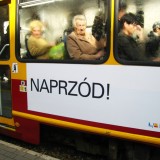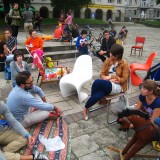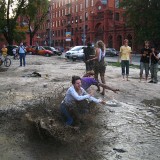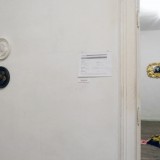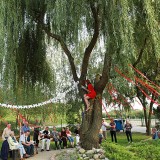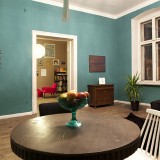Marcin Polak
An artist, a graduate of the £ód¼ Film School and a social activist. The following could be a brief description of Marcin Polak’s stance; a belief that art can fix the world and that its viewers can be general public and not only intellectuals. These are the views of the constructivist avant-garde. The identity of the £ód¼ artistic milieu originated out of this stance – represented by Katarzyna Kobro and W³adys³aw Strzemiñski. Marcin Polak continues this ideas using a more contemporary means of expression. Currently art is already after the lesson of postmodernism, so Marcin Polak knows that he won’t change the entire world through using art, but he may act locally and bring something positive to the life of people who surround him.
The artist works with excluded groups such as the homeless and children from dysfunctional families. However he also invites other artists to co-operate with him and enters into a coalition with cultural and artistic institutions. His stance may be considered engaged, which does not mean that the artist lacks a sense of humour, distance or “ease”. His projects are intelligent, unpretentious and through their simplicity, very strong in expression.
The work entitled Swedes poison with cigarettes is a reaction to the phenomenon of anti-Semitism and in particular, the thoughtlessly, almost automatically repeated slogans, that Jews are guilty of everything. The word “Jews” the artist replaced with the word “Swedes”. On the photos of the £ód¼ city walls after Marcin Polak’s intervention we could see: “Look how he destroyed Poland. Wa³êsa is a Swede”, “Don’t vote, they are Swedes!”, “A worker is a slave, the Swede employer stole...” etc. The slogans, which to unbiased people could seem embarrassing and frightening at the same time, became absurd also for the anti-Semites. But only to the point when we get used to them and start to treat them as a norm, because if “one says so”, then certainly there is a grain of truth in it… After all, Swedes attacked us once, we remember it from our history lessons, maybe they intend to invade our fatherland again?... As a matter of fact, the word “Jew” could have been replaced with any other as needed in a given situation and the more often we repeat it, the more probable that the whole world believes in it – says the artist. And the results of propagating such views we know from history…
In 2007 Marcin Polak made a statue of the mayor of £ód¼ at that time – Jerzy Kropiwnicki. The work was the reaction to the “crop” of various statues and other dodgy investments such as the fountain in front of the Grand Theatre in £ód¼ which appeared when he was in power. As a reaction to the propaganda of the authorities in the form of the placing of various symbols in the public space, Marcin Polak placed stones in various places in the town with plaques commemorating one of the achievements of the mayor. The sign on the plaque was “To the Mayor and the authorities of £ód¼ for the lost chance to participate in Euro Cup 2012 – the Inhabitants of £ód¼”. The action was approved of by the city dwellers and was widely commented upon in the local media.
In the work Shift (2006) Marcin Polak photographed obscure, devastated spaces with anti-Semitic graffiti in the centre of £ód¼ which we try not to look at. He then hung the photos of these spaces just under the billboards presenting candidates running for the local election. The relationship between the two presented a meaningful message for the inhabitants and the authorities of the city.
Neighbours (2009) was both an artistic and social project. Marcin Polak engaged with the people living close to the Art Museum who, for various reasons, do not visit this institution. He paid particular attention to two groups – children and youngsters from neighbouring yards and retired people – often lonely and having a lot of free time that they could devote to cultural encounters. Polak also invited other artists to participate in the project. Every artist had his/her group of people who then created an artistic project with him/her. They participated in various stages – concept, the choice of technique, material, preparation and the opening. The aspect of direct contact with the artist and the element of integration through for example, common meals were very important. It’s worth adding, that the centre of £ód¼ is inhabited mostly by the poorest and the least educated people. They live next to museums and galleries but they don’t visit them, and vice versa… Marcin Polak is attempting to change this. “One cannot assume that the whole surrounding community is doomed to the same fate, considering art as useless and far from real life” – says the artist.
In June of the same year, during the 20th anniversary of the first free elections in Poland since the collapse of communism, he incited Poles: “Be moustached-show solidarity. Grow a moustache for the 4th of June”. In this nice and non-pompous way the artist wanted to remind Poles about this milestone in the history of Poland and the icon of that change – Lech Wa³êsa. Various generations responded to the call to be moustached, including women!
As part of the Maknite project he brought to Budapest “Greetings from Poland” and revised the well known Polish proverb “Pole and Hungarian are brothers”. Hardly anyone is able to say what this liking between the two nations is about but everyone knows the saying. What is the reality? Marcin thinks that for many Hungarians we are as exotic as the countries in which palm trees grow. In the public space of Budapest he placed billboards with palm tree landscapes with the words in Hungarian “Greetings from Poland”. He also distributed postcards with the same image. The Polish images with palms were authentic. Recently in Poland there has appeared many palms, some of them have an artistic sense (such as the palm of the famous artist Joanna Rajkowska in Warsaw) but most of them have a decorative-tacky character – says the artist.
In 2011 together with the Atlas Sztuki Gallery, on the last day before the £ód¼ Fabryczna station was closed, he created a poetic and at the same time sublime situation. From loudspeakers the voice of soloists from the Grand Theatre in £ód¼ – Dorota Wójcik (soprano) and Przemys³aw Rezner (baritone) could be heard. They were singing and announcing the arrivals and departures of trains. For some it was the beginning of their trip, for some it was the end. It was a kind of farewell ritual – the railway station in its current form ended its existence. Let’s hope it will come back in a modern form.
Marcin Polak completed a project entitled Dozen or so people and stories with the inhabitants of a homeless persons in the shelter in Lublin. When we think of homeless people we usually think of those who need and require help. But it happens sometimes that the homeless also help others, as in the case of a man who took care of a neighbour’s the daughter so that she can go to work. Marcin collected stories that he heard and then tried to tell these together with the shelter’s inhabitants and the Chorea Theatre.
The project NO Apartment from 2012 was dedicated to the Wschodnia Gallery and presented as part of the £ód¼ Design Festival. It referred to the apartment and studio of Adam Klimczak, in which the two largest out of three rooms were given away to artistic activities. Marcin asked the question how this apartment might have looked if it was only an ordinary apartment. Marcin Polak turned the humble gallery space with the help of other artists in a luxurious, comfortable and carefully designed apartment, making everyone realise what Klimczak had resigned from by giving this space to the artists.
It is hard to list all the actions by Marcin Polak, but they all prove that the division between artist and viewer do not exist for him. Marcin is in some sense a cultural animator, but in his case, the animation has an added value – a non-conventional, critical but also stimulating view of reality. He treats himself and his art as a part of the community – of artists, £ód¼ city dwellers, Poles, citizens of the world. By acting locally he touches problems which are important for many contemporary societies.
Anka Le¶niak
more at the artist's website:


